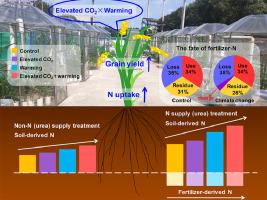Agricultural and Forest Meteorology ( IF 6.2 ) Pub Date : 2022-08-15 , DOI: 10.1016/j.agrformet.2022.109117 Jinyuan Zhang , Yansheng Li , Zhenhua Yu , Jonathan Adams , Caixian Tang , Guanghua Wang , Xiaobing Liu , Junjie Liu , Ashley Franks , Judong Liu , Shaoqing Zhang , Jian Jin

|
Plant nitrogen (N) acquisition is essential to both crop growth and yield. A rational N management strategy for agricultural systems under climate change is required but a knowledge gap still exists regarding plant N uptake and N origin (soil-derived N or fertilizer-derived N) in response to elevated atmospheric CO2 and warming. Our study investigated the responses of soil- or fertilizer-derived N uptake and yield of different cultivars of rice (Oryza sativa L.) to climate change. Five cultivars in the pedigree of a widely-grown rice cultivar Wuyoudao1 were supplied with and without urea, a commonly used N fertilizer in paddy soils and grown in open-top chambers under elevated CO2 (700 ppm) and warming (2°C higher than the air temperature). Plant N origins were traced using 15N-labeling technique (urea of 5% 15N atom). Compared to the control, elevated CO2 and warming increased N uptake by 17%, irrespective of N supply. Soil-N rather than fertilizer-N was the source of the increased N uptake. The increased soil-N uptake resulted in the enhancement of rice yield under climate change. Urea application did not alter the yield response to elevated CO2 and warming compared to the non-N supply, but did stimulate plant uptake of the soil-derived N. Although genetic improvement of rice germplasm resulted in an increase in plant N acquisition and yield, the history of crop breeding since 1935 did not alter the climate-change-induced response in terms of plant N acquisition. Our results suggest that climate change may lead to the depletion of the recalcitrant soil N pool in paddy soils, and that fertilizer-N-use efficiency may need to be factored into future breeding for rice genotypes adapting well to climate change.
中文翻译:

大气二氧化碳浓度升高和气候变暖促进了水稻品种从土壤中获取氮肥而不是尿素肥料
植物氮 (N) 的获取对作物生长和产量都至关重要。需要在气候变化下为农业系统制定合理的氮管理策略,但在应对大气 CO 2升高和变暖的情况下,在植物氮吸收和氮来源(土壤衍生的氮或肥料衍生的氮)方面仍然存在知识差距。我们的研究调查了不同水稻品种(Oryza sativa L.)的土壤或肥料来源的氮吸收和产量对气候变化的响应。向广泛种植的水稻品种五优道 1 的谱系中的五个品种供应和不供应尿素,尿素是稻田土壤中常用的氮肥,并在 CO 2升高的开顶室中生长(700 ppm)和变暖(比空气温度高 2°C)。使用15 N 标记技术(5% 15 N 原子的尿素)追踪植物 N 的来源。与对照相比,升高的 CO 2和变暖使 N 吸收增加了 17%,而与 N 供应无关。土壤氮而不是肥料氮是氮吸收增加的来源。土壤氮吸收的增加导致气候变化下水稻产量的提高。尿素应用不会改变对升高的 CO 2的产量响应与非 N 供应相比,气候变暖,但确实刺激了植物对土壤来源 N 的吸收。虽然水稻种质的遗传改良导致植物 N 获取和产量增加,但自 1935 年以来的作物育种历史并没有改变气候变化引起的植物氮获取方面的响应。我们的研究结果表明,气候变化可能导致水稻土壤中顽固的土壤 N 库的消耗,并且可能需要将肥料-N 的利用效率纳入未来育种能够很好地适应气候变化的水稻基因型。



























 京公网安备 11010802027423号
京公网安备 11010802027423号